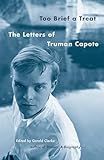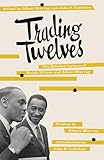The emails between Natalie Portman and Jonathan Safran Foer will soon be forgotten, while other correspondence is here to stay. Let’s go back to the days where writing letters was more about cultivating confidants and friendships, and less obviously a media stunt. Reading someone’s letters give us a glimpse into their private life — that’s why we love them. If you ever wondered what some of your favorite modern writers were composing when they weren’t polishing drafts of books that would go on to change the world, check out this list.
 Too Brief a Treat: The Letters of Truman Capote
Too Brief a Treat: The Letters of Truman Capote
Truman Capote was notoriously meticulous in his professional work, but his letters were quite the opposite. Sometimes scribbled in a mad five minutes, or written without a second thought to the whiplash of emotion within their lines, Capote wrote as though he were always leaning to whisper in your ear. His correspondence could rarely be classified as “cold,” even when making a professional request, such as writing to Elizabeth Ames — then in charge at Yaddo — on behalf of a young writer named Patricia Highsmith, whose work Capote thought held real talent (Highsmith was later accepted to Yaddo, where she wrote part of her first novel, Strangers on a Train).
 In Tearing Haste: Letters Between Deborah Devonshire and Patrick Leigh Fermor
In Tearing Haste: Letters Between Deborah Devonshire and Patrick Leigh Fermor
Deborah Mitford, the Duchess of Devonshire and the youngest of the six Mitford sisters, invites British author and OBE recipient Patrick Leigh Fermor to her royal home, a visit that sparks a half-century of friendship and scintillating correspondence. When they began to write each other in the early 1950s, Fermor had secured his reputation as a respected author, but Mitford admittedly could never bring herself to read his books, claiming to not be much of a reader. But Mitford undersells herself: their exchange is sophisticated, witty, and often full of energy and a lyrical beauty while indirectly documenting cultural and societal milestones. This collection features an impressive list of cameo “appearances,” including Evelyn Waugh, Fred Astaire, and John F. Kennedy.
 Zora Neale Hurston: A Life in Letters
Zora Neale Hurston: A Life in Letters
Zora Neale Hurston became a prominent literary figure after the publication of Their Eyes Were Watching God. But Hurston wrote much more than she published during her lifetime, and at her passing, her estate contained numerous story manuscripts, essays, plays, and more. This collection of approximately 600 letters, written to various individuals including fellow writers Langston Hughes and W.E.B. Du Bois, is a beautiful reflection upon Hurston’s life, the challenges she faced, and the doors she opened for others.
 Habit of Being: The Letters of Flannery O’Connor
Habit of Being: The Letters of Flannery O’Connor
For anyone who is even a minor fan of Flannery O’Connor, this collection is a great glimpse into the author’s very human side. Humorous, angry, arrogant, curious: the many different facets of Flannery O’Connor are revealed here. What readers may find most intriguing are some of the (300) letters exchanged between “Betty” Hester and O’Connor, whose intellectual exchanges provided the foundations of a powerful epistolary friendship for the recluse Hester, and whose letters were sealed for 20 years before they could be released in part here.
 Thinking of Home: William Faulkner’s Letters to his Mother and Father
Thinking of Home: William Faulkner’s Letters to his Mother and Father
William Faulkner’s infamous complexity shifts to a softer side in his correspondence with his parents. These letters show a different personality that only a few people rarely observed. In the letters compiled during the short window of 1918 to 1925, we are given a glimpse of Faulkner’s life until he returned home to study at the University of Mississippi, including details from his travels to New Haven, New York, Paris, and New Orleans. During his stint with the Canadian flyers of the Royal Air Force, Faulkner mused about his training and war itself. His sense of longing for his home and family in Oxford, Miss., gives us the biggest glimpses into the heart of who Faulkner was as a young man forming the writer he would become.
 Trading Twelves: The Selected Letters of Ralph Ellison and Albert Murray
Trading Twelves: The Selected Letters of Ralph Ellison and Albert Murray
For lovers of music and literature, this collection belongs on the shelf. When American literary and jazz critic Albert Murray and author Ralph Ellison began their correspondence in 1950, Ellis was in New York City and Murray was in Alabama. Their letters are surprisingly funny, full of anecdotes and opinions on pretty much everything: from their families to contemporary writers to musical greats to the advancements of African Americans over the decades. Their admiration for each other is made clear, as Ellison writes: “You’re the only one I really write to and, other than a wild, Russian chick of a girl whose now in the states and who wouldn’t write home for eating change, my only friend.” The writers’ friendship lasted until Ellison’s death in 1994, but this curated set of letters are pulled from 1950 to 60.
 Between Friends: The Correspondence of Hannah Arendt and Mary McCarthy 1949-1975
Between Friends: The Correspondence of Hannah Arendt and Mary McCarthy 1949-1975
In this collection, we climb into two of the 20th century’s greatest minds — minds that were in proximity to some of the most important people and events of the times. Hannah Arendt, a German-born American philosopher and political scientist shared an enviable friendship that spanned continents with Mary McCarthy, an American novelist and literary critic. Both women were members of the Partisan Review and spent much time discussing Joseph Stalin and Leon Trotsky. The collection is notably unbalanced, with twice as many letters written by Arendt. Their letters contained not only gossip and relationship details (many concerning McCarthy’s four marriages) but also lively discussions of literature, the reach of fascism, and individual morality and common sense. Their friendship wasn’t without its snags, such as when McCarthy admitted her sympathy for Adolf Hitler — he seemed, she argued, to want the people of occupied France to like him –which offended Arendt, a German-born Jew, who had barely escaped Nazi clutches.
 Letters Home by Sylvia Plath: Correspondence 1950-1963
Letters Home by Sylvia Plath: Correspondence 1950-1963
One of the most notable names in all of literature not only for her work but her death, these letters give a glimpse into a troubled, brilliant mind. What is striking about this collection is that the letters span 13 years of correspondence between Sylvia Plath and her mother. In these pages, readers will learn more about Plath’s college years; her relationships, both platonic and romantic, and the waxing and waning of her marriage to a man she considered her male counterpart; and the births of her children. There is an element of falsehood to the letters, a front Plath put forth to shield her mother from the depth of her personal struggles. The letters, released by her mother, could be seen as an attempt to rewrite the framework of Plath’s life as her mother would have us see it.
 Letters From Langston: From the Harlem Renaissance to the Red Scare and Beyond
Letters From Langston: From the Harlem Renaissance to the Red Scare and Beyond
I recommend reading The Selected Letters of Langston Hughes, but for those who want to dig deeper and immerse themselves in the mid-century Black radical experience, this collection is a gem. Hughes, a talented poet and one of the most important modern contributors to American literature, rose through his writing to become one of the leaders of the Harlem Renaissance. This collection spans 35 years, ending just before Hughes’s death in 1967, and weighs in at a whopping 440 pages. The correspondence between Hughes and his four best friends — Matt and Evelyn Crawford, and William and Louise Patterson — encapsulates what it’s like to grow up Black, leftist, resilient, and focused. It’s a blend of politics and art which may inspire others in our current political climate.








